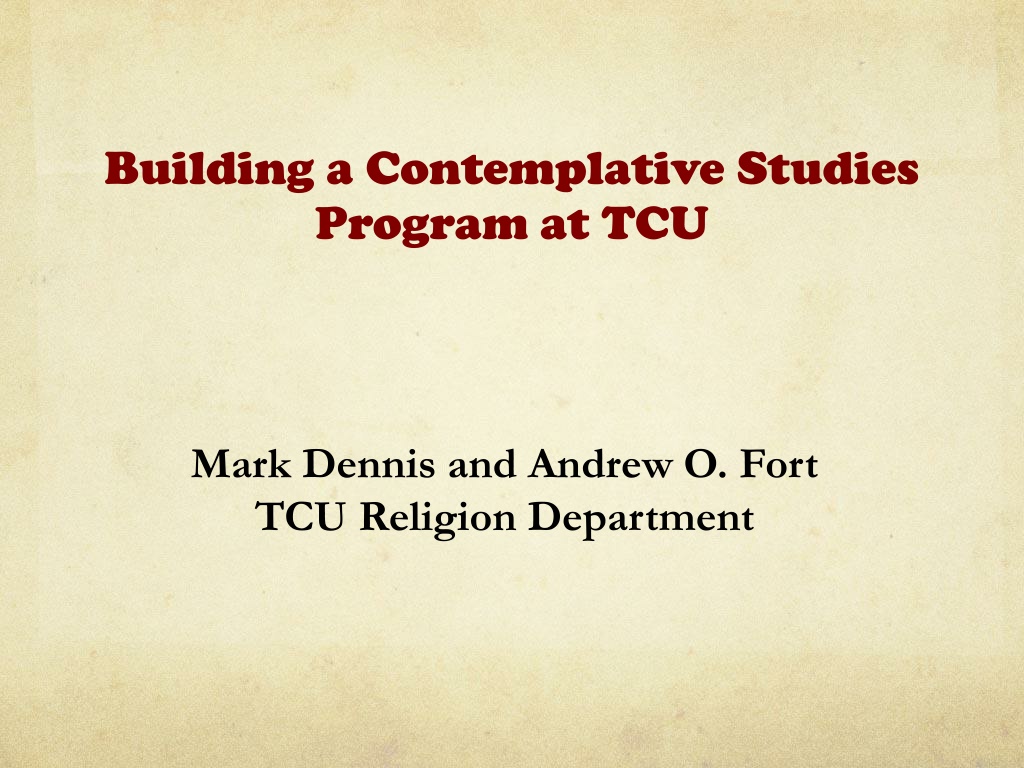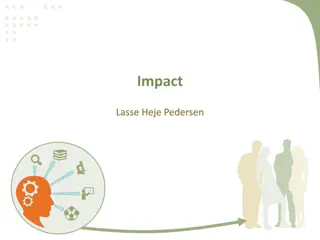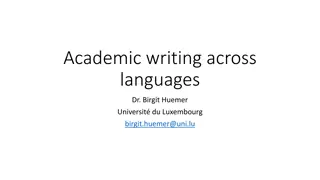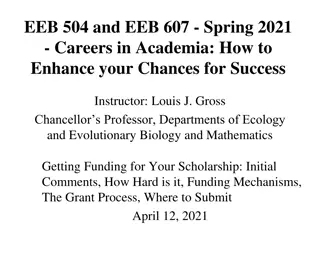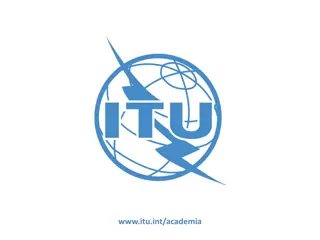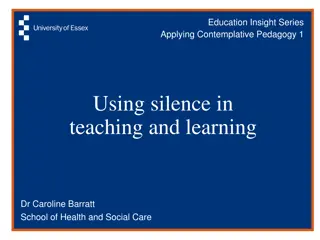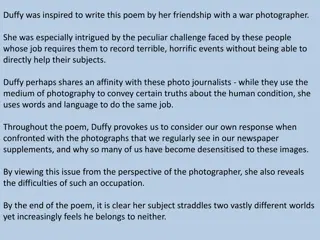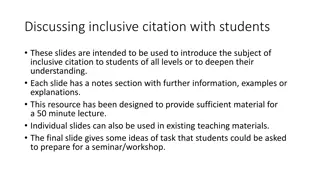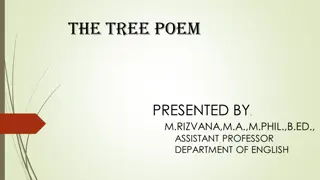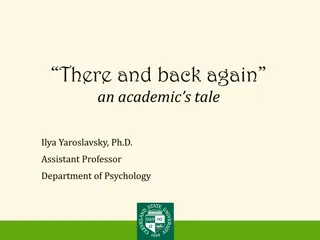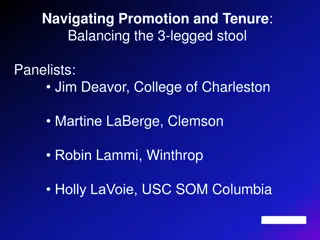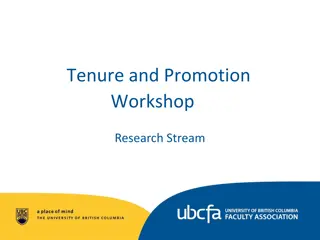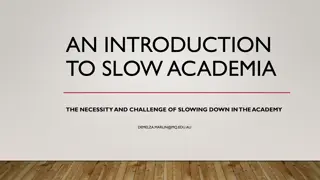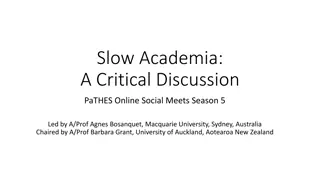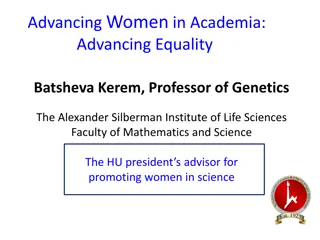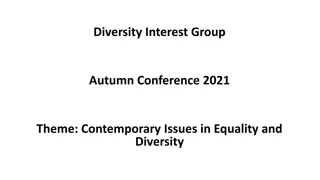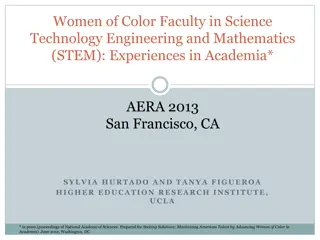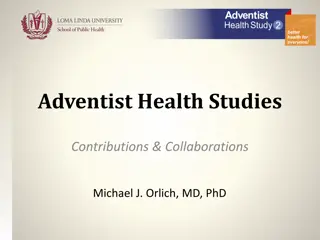Exploring Contemplative Studies in Academia: A Comprehensive Overview
Contemplation, a diverse practice encompassing reflection and inward focus, is explored through various contemplative practices. Contemplative Studies involves critical reflection on theory and practice, integrating contemplative pedagogy into academia. Different learning perspectives - first, second, and third person approaches - are discussed to enhance understanding and teaching effectiveness.
Download Presentation

Please find below an Image/Link to download the presentation.
The content on the website is provided AS IS for your information and personal use only. It may not be sold, licensed, or shared on other websites without obtaining consent from the author. Download presentation by click this link. If you encounter any issues during the download, it is possible that the publisher has removed the file from their server.
E N D
Presentation Transcript
Building a Contemplative Studies Program at TCU Mark Dennis and Andrew O. Fort TCU Religion Department
What is contemplation? There is no agreed upon definition of contemplation, but it can be used as a cross-cultural umbrella term, referring to a broad array of ways of reflection and focusing attention, sometimes but certainly not always part of a religious tradition. It often includes a present-centered inward focus of attention and/or detached observation, suspending judgment and ego-based thinking and feeling. Aims range from a sense of calm to higher insight or wisdom. .
There are a wide variety of contemplative practices: simple attending to the present, breathing and other kinds of mindfulness practices, reflective self-inquiry, observing nature, sitting or walking meditation, yogic postures, visualizations, silent prayer and group chanting, and many others.
What is Contemplative Studies? It s an inquiry into and critical reflection on the nature and significance of contemplative theory and practice. Contemplative pedagogy teaches about both contemplative theory and practice. Students want to learn this way, and we want to teach it more effectively. However, in academia, we need to be able to intellectually justify contemplative pedagogy to our colleagues, and demonstrate that it fits into, and even enhances, liberal arts education.
First, Second, and Third Person Approaches Contemplative pedagogy addresses different ways of learning, which we call 1st, 2nd, or 3rdperson perspectives.
Third Person In the third person educative style, an expert introduces objective or neutral information and shares knowledge (by readings, lecture, etc.) from a discipline, such as (in Religious Studies) a worldview and others ways of thinking in their historical and cultural context. The teacher also encourages empathetic understanding or mental migration into this worldview and questions students about their understanding of it. This third person approach is important, but not complete.
First person Contemplative pedagogy takes the additional step of providing the opportunity for the student s subjective or first person experience of contemplative practices under study. First person exercises demonstrate the value of students being present to their own experience (mind and body) and encourage an increased understanding of both their own experience and others perspectives through direct self-reflexive thought and writing. A critical first person perspective makes one more objective in giving the ability to recognize and acknowledge one s own subjectivity.
Second person A fuller understanding of self and others is also enhanced by second person intersubjective experience: deep listening while interacting with others, group sharing (including disagreement and doubt), paired conversation, and peer questioning and support. It is important to add that this respectful consideration of the students own first and class s second person perspectives shows the teacher takes seriously the students own experience, valuing them in a way not always present in traditional education.
Link to Liberal Arts Education In the academic context, all these elements work together to enrich classic liberal arts goals known as critical thinking, which include the following: recognizing and critiquing one s own beliefs and assumptions as well as accurate and respectful understanding (and informed criticism) of others; learning in depth about one s own and others historical and cultural conditioning; higher order thinking of analysis, integration, and synthesis; and value and personal meaning clarification for oneself and about society. In a later session, we can discuss how to utilize various tools to measure learning.
Enhancing Liberal Arts Education Contemplative pedagogy also assists in reaching objectives beyond critical thinking which are central parts of liberal education. There is evidence that contemplative practices offer positive results for goals of individual and social well- being such as increased capacity for focused attention and concentration, emotional regulation, mental and physical health, resilience, and empathy and compassion. These are especially important given the speed of change, distraction, and (over)stimulation found in our society today. In the later session, we can discuss programs in various universities researching these aspects of human flourishing.
Interlude Mentor appreciation exercise: Starting with your earliest memories to the present day, reflect on your most influential teachers, mentors, and/or role models. Think about a couple of mentors for one minute each and then take another minute to write a few sentences on how and why each was important. Do you know who their teachers were? Did you ever express gratitude to them? Would you be willing to choose one (or more) and do that over the next 24 hours?
Development of the program at TCU The process began with two regional workshops on building Contemplative Studies (CS) in the Southwest in March 2011 and June 2012. August 2012: Formation of TCU CS faculty interest group with coordinator and steering committee (but no dedicated space, funds or staff to this day). We meet semester beginning and end to plan and review.
Goals Focus on pedagogy and CS s relationship with liberal education Commitment to interdisciplinarity (but key players make a difference, and have changed over time) Monthly meetings/events: We set and continue a pattern of monthly events (most including a basic meditation practice) with a major speaker each semester (speakers draw 35-65 depending on extra credit)
Ongoing events I) Panels (with faculty and students) on contemplative theory and practice: Issues discussed on panels over the years: i) definition of key terms in CS; ii) practices for classroom and for personal use; iii) ethical issues in CS; iv) epistemology/ways of knowing/worldviews of contemplative traditions; v) social/cultural influences (new media, commodification, therapy, etc.) vi) how to address lack of academic reward system for contemplative practice
II) Movies (ex.: Samsara, Doing Vipassana/Doing Time, In Pursuit of Silence, Kumare) III) Other activities: A Counseling Center staff member leads a number of 5-week student group meetings about using meditation etc. to address stress, anxiety, and sleep issues based on Mindfulness for the Next Generation (H. Rogers, M. Maytan) Weekly meditations at Religious and Spiritual Life office, Brite Divinity staff member leads weekly Zen meditation and silent sits Labyrinth and Froghenge walks
Courses While there is no Contemplative Studies minor with designated courses, we and an increasing number of colleagues include contemplative exercises in various courses, including a course on Buddhism as well as those in philosophy, anthropology, nursing, and dance. We are also invited to discuss CS and lead exercises in other classes including business and media ethics.
Funding sources Center for Teaching Excellence Liberal Arts college Honors College Nursing and Science and Engineering Colleges Religion Department Asian Studies minor TCU Global Citizenship Program International Studies Programs We also plan to ask for funds from the new Medical School
SELECTED MAJOR ACTIVITIES BY SEMESTER Fall 2012 (first group event): What is Contemplative Studies, and what is its place at TCU? Brainstorming and networking We began holding additional monthly meetings/events as indicated above Spring 2013: Stress, wellness, and contemplative practice workshop co-sponsored with TCU nursing program
Fall 2013: Louis Komjathy (Univ. San Diego) spoke on Imagining the Contemplative University and Studying What One Practices and Practicing What One Studies: A Daoist Professor s Perspective Spring 2014: Ruben Habito (SMU/Perkins), "Christian Contemplation and Buddhist Practice, presentations for undergraduates and divinity school students Also, Cognitive Neuroscience and Meditation, by a psychology faculty member and student (on surfing as meditation)
Fall 2014: Barbara Dilley of Naropa University, presentations on contemplative movement Off campus presentations at numerous conferences attended by steering committee members Spring 2015: Mindbodyness course, Andy Fort and modern dance professor Start of annual contemplative poetry competition (17- 30 entries submitted) Cash prize and winning poem placed in TCU student literary magazine
Fall 2015: Counseling and Contemplation, Sumith Fernando Contemplation and Social Justice Issues conversation Spring 2016: John Dunne, Center for Healthy Minds, Univ. of Wisconsin: The Contemplative Scientist and other presentations First meeting with Science and Engineering Dean and Medical School faculty concerning connections with new medical school Meeting with director of TCU Health Center
Fall 2016: Bobbi Patterson (Emory University), presentations on contemplative pedagogy Mark Dennis s course Mindfulness and Millennials now ongoing pedagogy discussion with English/Womens Studies faculty Presentation on Contemplative Studies at Moore Symposium, theme: What Makes Us Human?
Spring 2017: John Dunne and Cliff Saron (UC Davis): presentations at TCU Honors Convocation and elsewhere during Honors Week Meetings with Honors, Science, and Medical School Deans, and meeting with Medical School communications staff Meditation and Integrative Medicine presentation Philosophy course on Mind, Consciousness, and Self with contemplative elements
Fall 2017: Andy Fort appointed Green Emeritus Tutor to continue building the Contemplative Studies program Follow up meetings with Honors College on a CS course, and with Med School staff, and another visit by Alejandro Chaoul, MD Anderson Cancer Center panels: -DACA loving-kindness meditation -Christian contemplatives -managing student stress Additional courses with contemplative content (Religion, Philosophy, Anthropology, Dance) Off campus: Brown think tank on building CS programs in U.S.
Spring 2018: Mark Dennis gets course reduction to hold meetings with interested faculty about developing TCU s CS program and building our first website Leaders of MD Anderson s Center for Integrative Medicine meet with leaders of TCU s Medical School Mindful connectivity panel, AsiaNetwork meeting in Philadelphia Keynote at Big XII teaching excellence centers meeting at TCU Discussions with TCU University Programs office, which is developing the course Introduction to College Life with contemplative elements Creation of student group interested in Contemplative Studies
Fall 2018: Mark and Andy prepare CS course in TCU Honors College for spring Planning visit by leaders of Brown University s CS program Additional meetings with Medical School faculty/staff Other possibilities: -tai chi -contemplation and music/art -contemplative writing seminar
Evaluation Successes: Increased awareness of CS throughout university Enthusiastic and collegial interdisciplinary steering committee Regular and diverse presentations, visits from leading figures in CS Increased infusion of contemplative exercises in various disciplines Interest of and support by Honors Dean Increasing participation by Science and Health Care faculty Future participation by new Medical School Challenges: creating self-sustaining student group Building a minor/concentration with regular CS courses
Possible Exercises Silence to start class, attend to breath Focused attention (as in body scan) Open monitoring ( mindfulness ) Visualizations/guided imagery ( go to beach/lake/mountain ) metta ( loving kindness ) exercise Walking (slowly): garden, labyrinth, nature (alternating senses) Digital awareness exercise Contemplation with art or music 2ndperson exercises: deep listening, class interbeing (centering as a group)
Loving Kindness (metta) Exercise May you be happy, may you be well, may you be at peace
Evaluation/Grading With some careful thought, one can evaluate contemplative study in quite familiar terms: What is the student s depth and quality of knowledge, reasoning, and insight about the history, theory, and practice of the subject matter? Did students (1) do the assignment, (2) comprehend the reading and lecture and critically reflect on them,
(3) gain insight through exercises into the readings and their context, the process of practice, and oneself (perhaps comparing expectations with actual results), (4) organize and express their thoughts with clarity and sophistication, and (5) use good writing mechanics? One might also offer and utilize student efforts at self-assessment (degree and quality of effort and insight).
Mindbodyness: Contemplative Movement and Reflection Possibly the first contemplative course ever co-taught by Religion and Contemporary Dance professors (Susan Douglas Roberts and Andrew Fort) We met in a dance studio twice a week for 80 minutes. In most cases, the first half of the class was a contemplative movement practice (at different times, the movement included some combination of lying, sitting, and standing; walking, both straight and in circles/while turning; students moving solo, paired, or as a group; practicing various breathing styles; proceeding as an animal; and other actions). This was followed by journaling and conversation, and then we turned to lecture and discussion about some aspect of mindbodyness, with reference to the day s reading.
Brief Course Lecture Outline The course was loosely divided into units: we first considered definitional and theoretical issues in contemplative studies, then various conceptions of mind and body in the modern West and in traditional Asia (including Indian Yoga, taijiquan, and Tibetan and Zen Buddhism; we also discussed Native American traditions). Some ideas were introduced by me, and others by an array of TCU faculty and off campus guests, including a three day visit by Judith Simmer- Brown of Naropa University.
As the semester continued, students were assigned an increasing number of exercises, including week long practices of mindfulness meditation and the five basic Buddhist precepts. There were also day long exercises of silence and being aware of digital attachment, a practice of contemplative walking (beginning with John Francis s TED talk on silently walking the earth ), and a labyrinth walk. Near the course end, we read Jeff Wilson s recent Mindful America (New York: Oxford University Press, 2014), which raised important issues of cultural adaptation, appropriation and commodification that the class participants found quite thought provoking.
Final Project The course concluded with a final contemplative project by each student, which included both movement and reflection (indoor and out). Some examples were slow walking amid Froghenge, the circular array of sculptured rocks in the center of campus; circling a building while looking at it closely and carefully; being present with trees as witnesses and elders; listening to singing bowls; staying aware while doing repetitive motion; being with a partner with eyes open then moving in concert with one s eyes closed; slow rolling while attending to all parts of the body; walking a mini-labyrinth; and expressing gratitude to the body from feet to head while walking.
Student Feedback In class and in anonymous semester end feedback, students expressed great appreciation for the course as providing new and different ways of knowing mind and body and their connection, both theoretically and on a real, experiential level. They especially valued learning what guest teacher Alejandro Chaoul called meditation pills, tools to quiet and center themselves during the daily rush of university life. The idea of finding cues for brief respite or quiet time in daily life became a course theme, reinforced by other visitors. There was a striking emphasis on how much they welcomed and integrated simple and practical self-care skills of focused breathing and being present; this was especially important for and appreciated by the many seniors with an uncertain future after graduation. One said, beautifully, this course became a refuge rather than a requirement.
But students also expressed frustration with the workload, both the amount of writing (weekly short papers, plus responses to the meditation exercises and the final project) and out of class practice, feeling (justifiably in retrospect) that we required too much in too concentrated a time. They and especially we also felt that there was insufficient time to adequately address all the material introduced in class.
